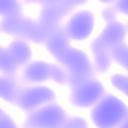Periodic Caustic Maps
This research is concerned with the creation of periodic caustic texture
maps. These maps are periodic in both time and space. These maps can be
used to add visual detail to a scene involving water flows in a
straightforward manner by mapping the caustic maps onto the scene's
geometry. Of course the resulting maps are not physically correct ,
but they can greatly enhance a water simulation at almost no additional cost.
The maps are created by first creating periodic water surfaces using an
inverse FFT synthesis technique. Then, for each time-sample, the
corresponding caustic map is computed for a given depth. The later is computed
by using OpenGL.
Here are three examples of ``caustic maps'', they were created using
standard OpenGL routines. Each frame at a resolution of 256x256 took only
2 seconds to render on an RS4000 SGI Indy. The caustics result from the
defocusing and focusing of light by an undulating water surface. The
dimensions of the water patch are:
magnitude of fluctuations: 5 cm
side length of patch: 1 m
length of one cycle of the animation: 1 sec
Here are the tree animations for depth equal to 50 cm, 4 meters and 8 meters
respectively.



Here is an example of an animation where I duplicate the same tile three
times in the x and y directions:
click here to see the animation
The periodicity can be annoying, therefore I have done some research into
using aperiodic texture maps
Back to my research page





